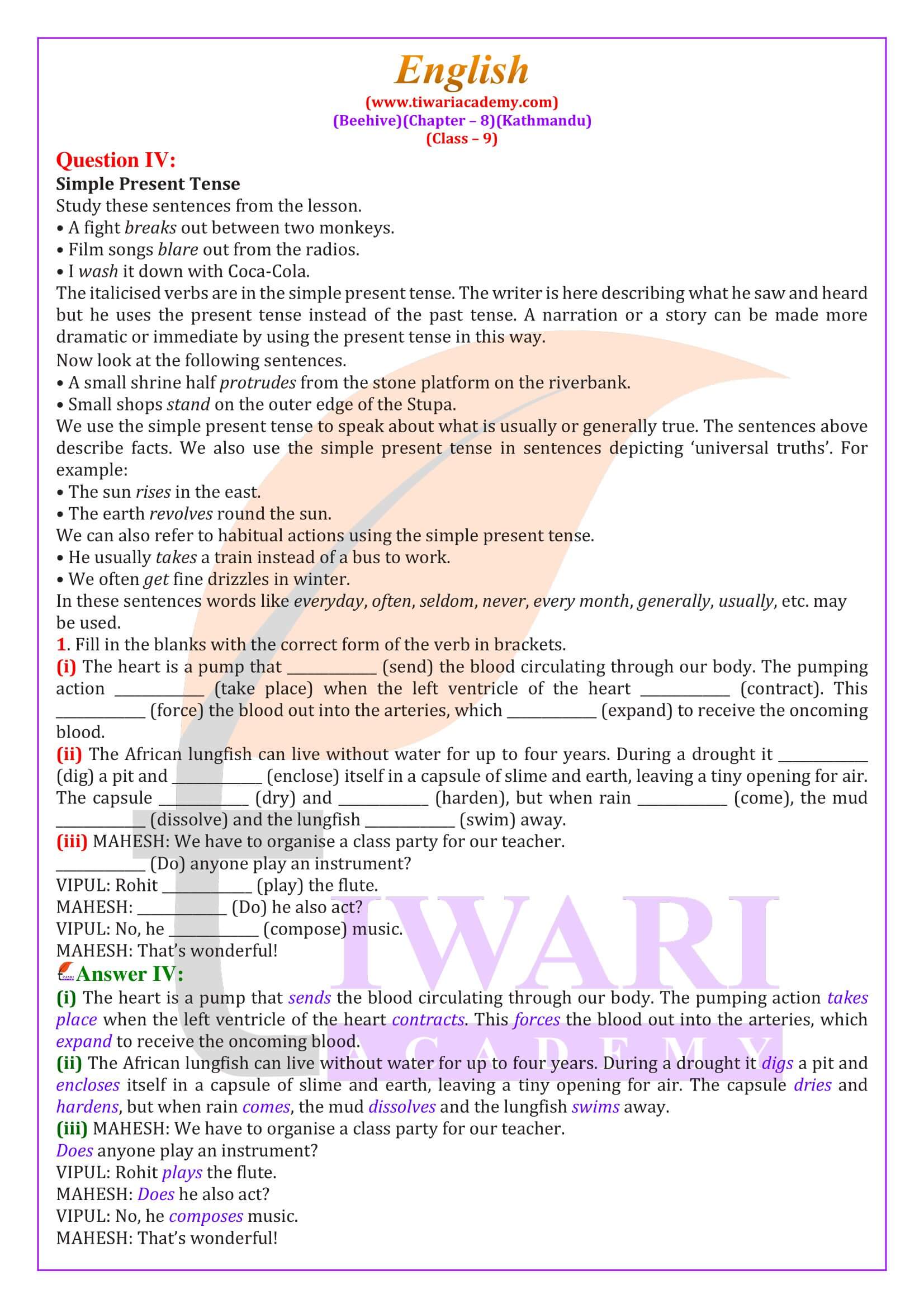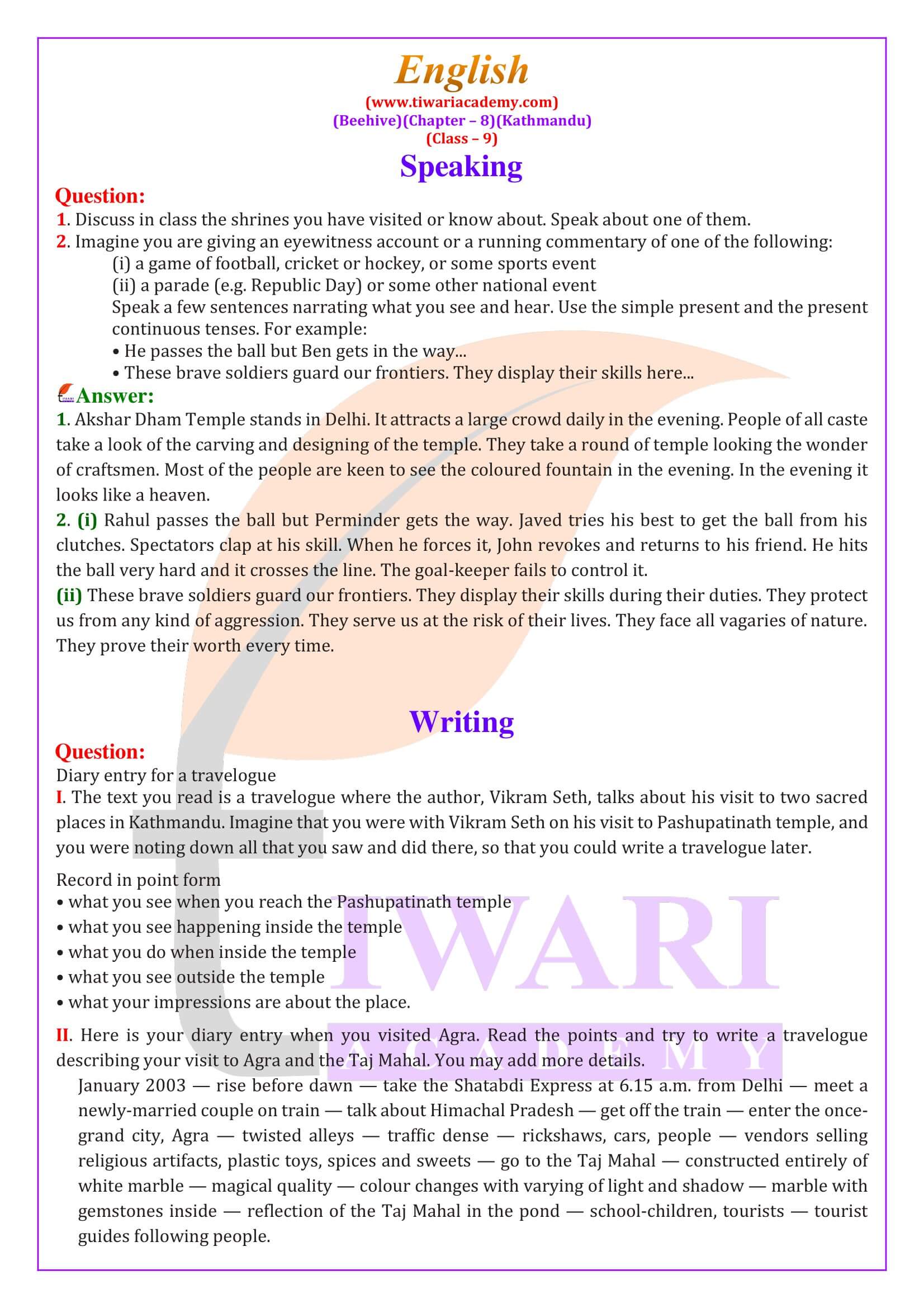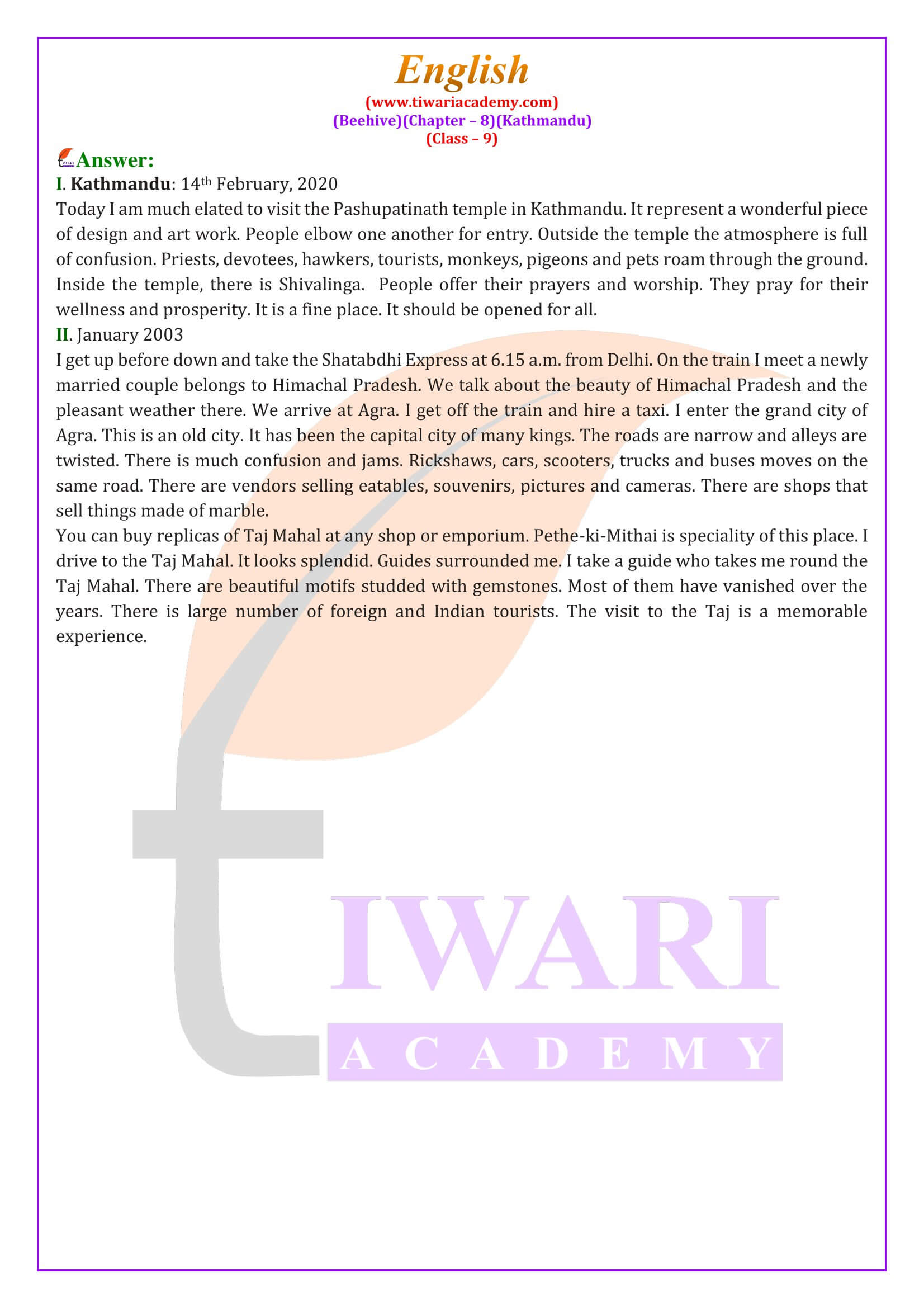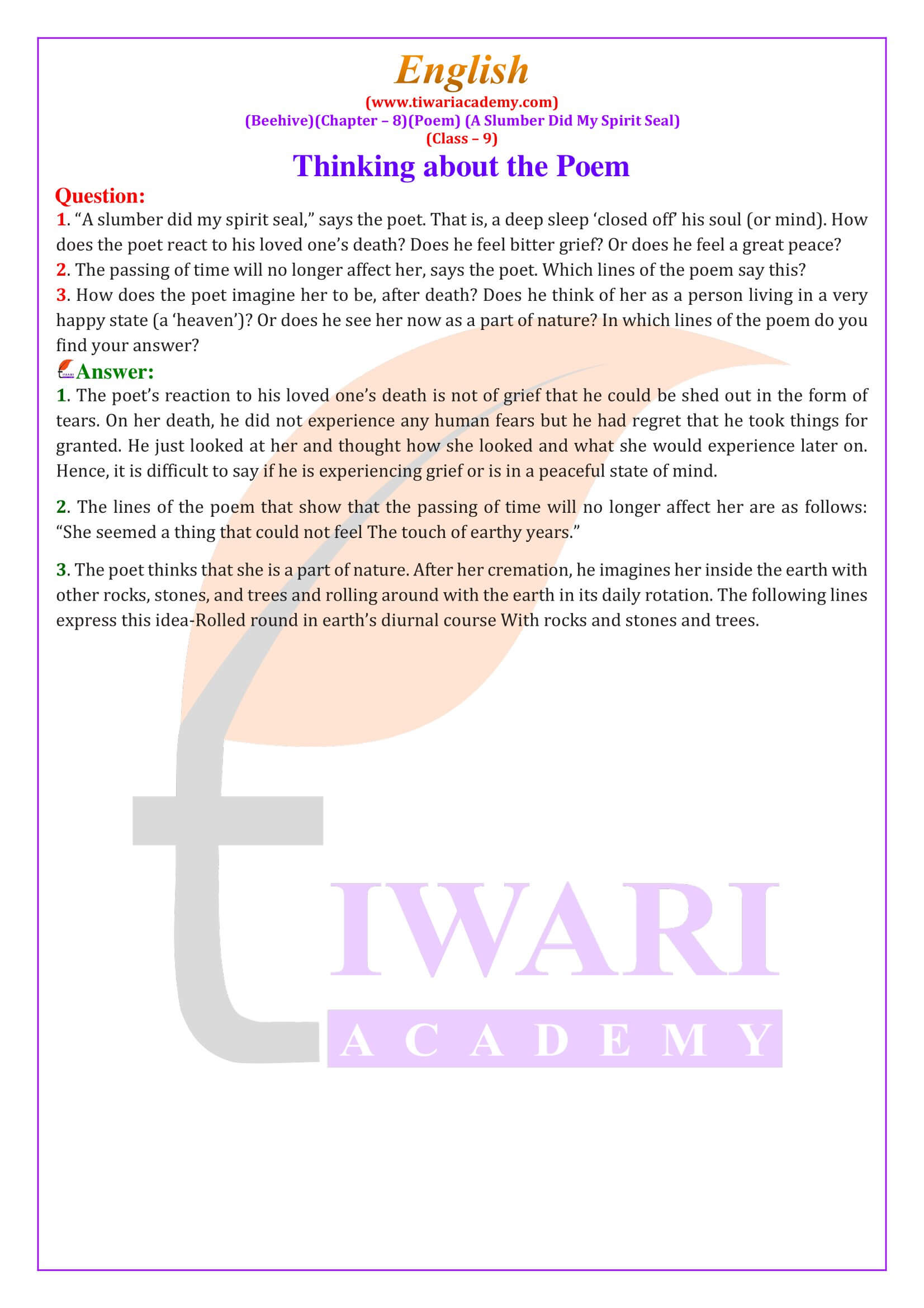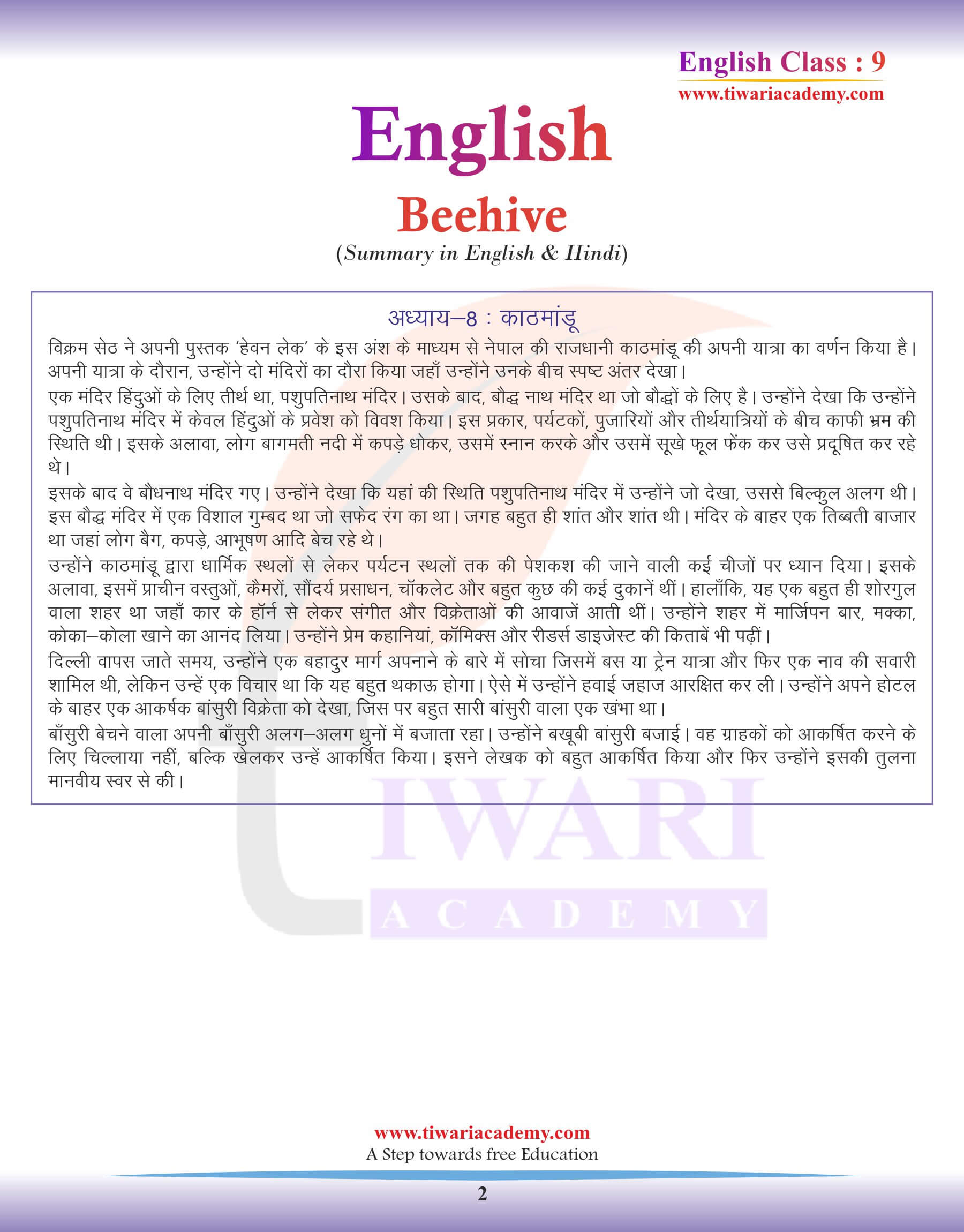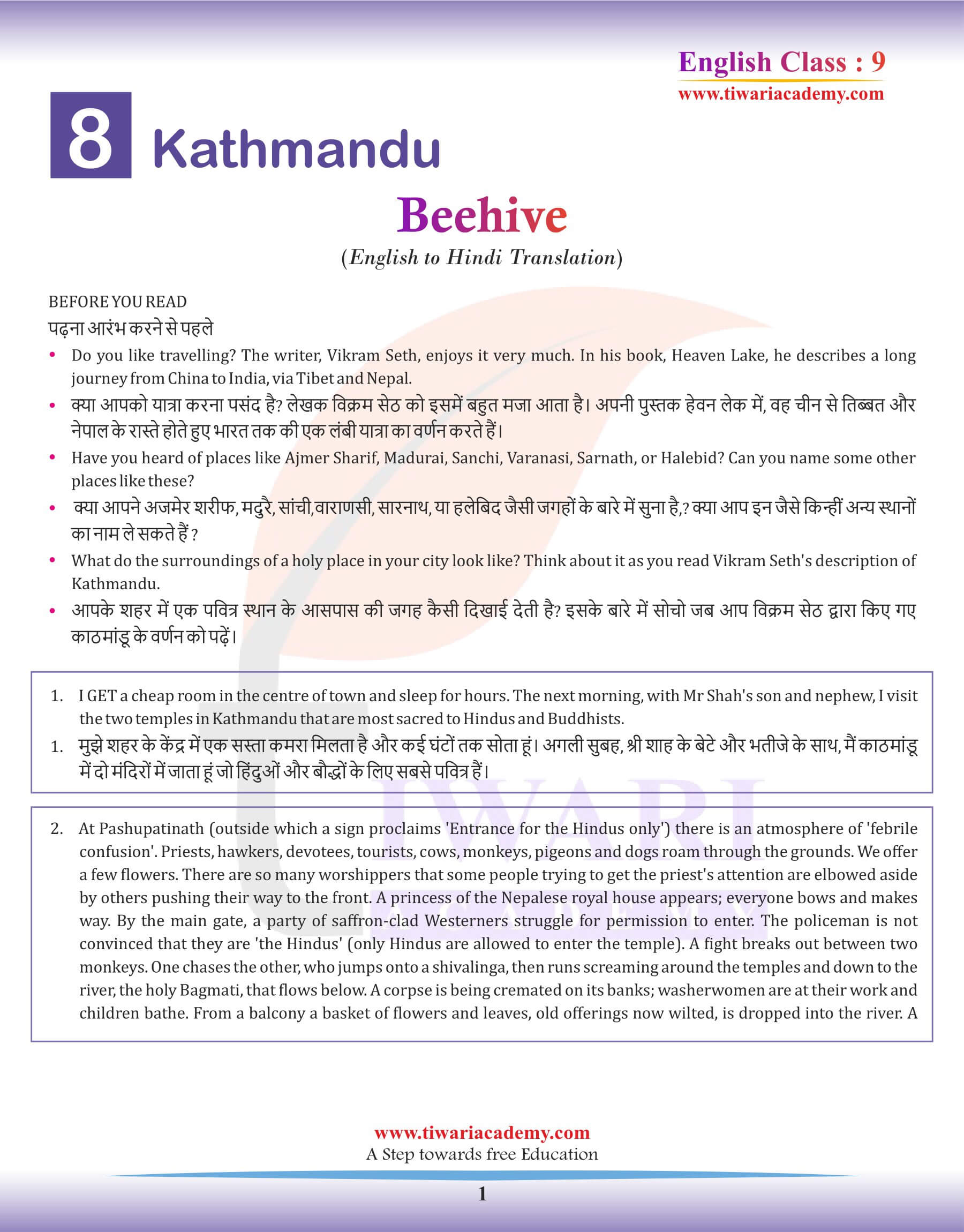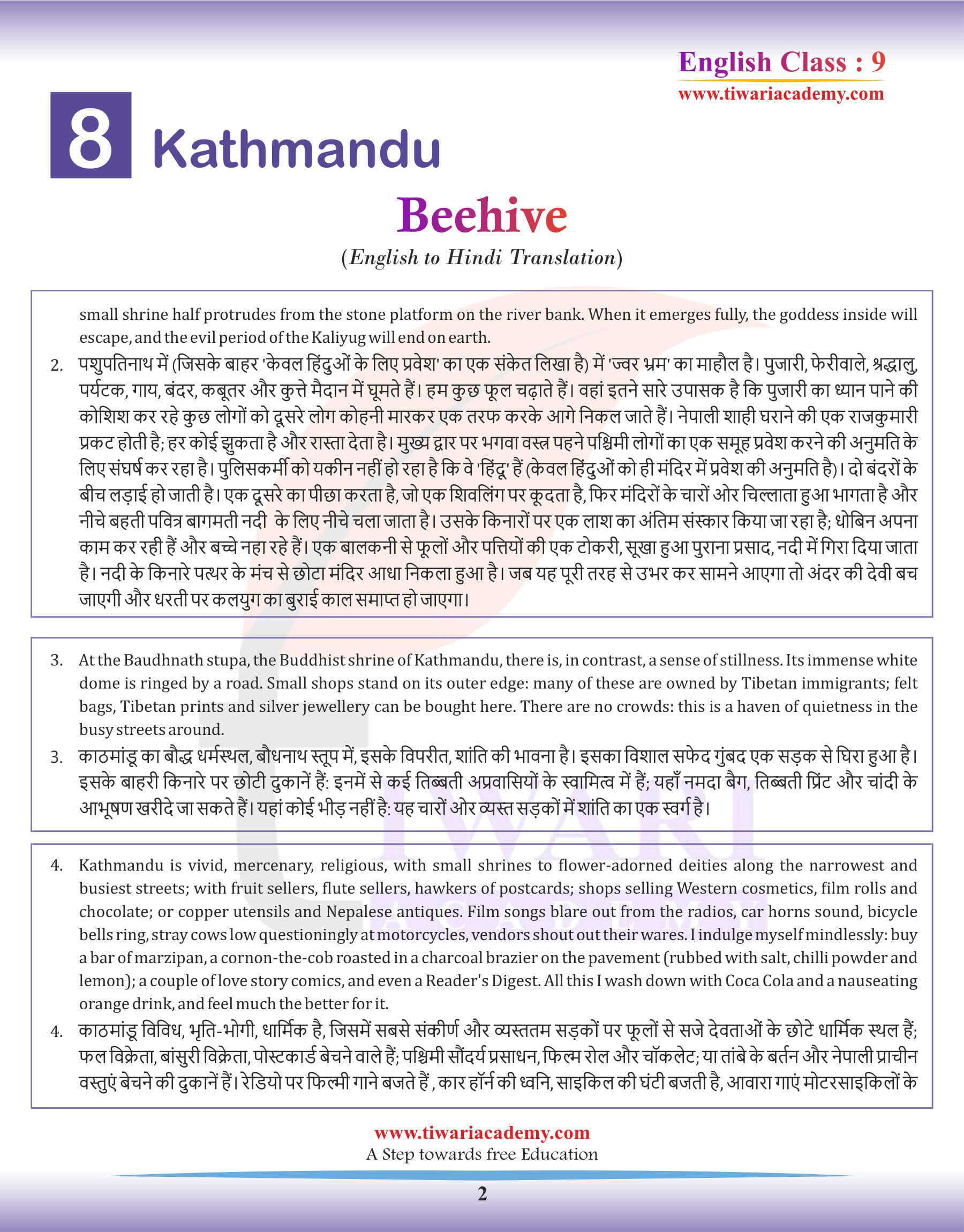NCERT Solutions for Class 9 English Beehive Chapter 8 Kathmandu and the poem A Slumber did My Spirit Seal in Hindi Medium (Hindi Translation) Summary in Hindi and English. Class 9 English solutions are revised and updated according to rationalised NCERT books published for academic session 2025-26.
NCERT Solutions for Class 9 English Beehive Chapter 8
Class 9 English Chapter 8 Question Answers
- Class 9 English Beehive Chapter 8 Kathmandu
- Class 9 English Beehive Chapter 8 Poem A Slumber did My Spirit Seal
- Class 9 English Beehive Chapter 8 Summary
- Class 9 English Beehive Chapter 8 Hindi Translation
- Class 9 English Beehive Chapter 8 NCERT Book
- Class 9 English NCERT Solutions
- Class 9 all Subjects NCERT Solutions
| Class: 9 | English |
| Textbook: | English Reader – Beehive |
| Chapter 8: | Kathmandu |
| Content: | Solutions, Translation and Summary |
| Content Type: | PDF, Images and Videos |
| Academic Session: | 2025-26 |
9th English Beehive Chapter 8 Question – Answers
NCERT Solutions and Question – Answers of Class 9 English Beehive Chapter 8 Kathmandu & the poem A Slumber did My Spirit Seal are given below to use online or download in PDF for free. All the solutions 2025-26 are updated for new academic session 2025-26.
Passages for Comprehension
I. READ THE PASSAGE GIVEN BELOW AND ANSWER THE QUESTIONS THAT FOLLOW:
A fight breaks out between two monkeys. One chases the other, who jumps onto a shivalinga, then runs screaming around the temples and down to the river, the holy Bagmati, that flows below. A corpse is being cremated on its banks; washerwomen are at their work and children bathe. From a balcony a basket of flowers and leaves, old offerings now wilted, is dropped into the river. A small shrine half protrudes from the stone platform on the river bank. When it emerges fully, the goddess inside will escape, and the evil period of the Kaliyug will end on earth.
Questions:
1. Where does the fight take place and between whom?
2. Describe the activities which are seen on the banks of the Bagmati River.
3. What is dropped from a balcony into the river?
II. READ THE PASSAGE GIVEN BELOW AND ANSWER THE QUESTIONS THAT FOLLOW:
A princess of the Nepalese royal house appears; everyone bows and makes way. By the main gate, a party of saffron-clad Westerners struggle for permission to enter.
Questions:
1. Why were the Westerners not allowed to enter?
2. Where is the Pashupatinath Temple situated?
3. Which dignitary come to the temple?
III. READ THE PASSAGE GIVEN BELOW AND ANSWER THE QUESTIONS THAT FOLLOW:
From a balcony a basket of flowers and leaves, old offerings now wilted, is dropped into the river. A small shrine half protrudes from the stone platform on the river bank. When it emerges fully, the goddess inside will escape, and the evil period of the Kaliyug will end on earth.
Questions:
1. What is dropped from the balcony?
2. Where is the small shrine?
3. Where do most of the activities take place?
Suggested Answers of Passages
Answers for Passage I:
1. The fight takes place between two monkeys in a ground outside the temple of Pashupatinath.
2. A corpse is being cremated, washerwomen are washing their clothes and children are bathing.
3. A basket of withered flowers and leaves is dropped into the river from a balcony.
Answers for Passage II:
1. The Westerners were not allowed to enter because only Hindus were allowed in the temple.
2. Pashupatinath temple is situated in Kathmandu, Nepal.
3. A princess of Nepalese royal family came to the temple.
Class 9 English Beehive Chapter 8 – Important Questions
The two temples visited by the author in Kathmandu were the Pashupatinath temple and the Baudhnath stupa.
The writer says, “All this I wash down with Coca Cola.” What does ‘all this’ refer to?
‘All this’ refers to eating a bar of marzipan, a corn-on-the-cob roasted in a charcoal stove (rubbed with salt, chilli powder and lemon), and reading a couple of love story comics and a Reader’s Digest.
What does Vikram Seth compare to the quills of a porcupine?
Vikram Seth compares the fifty or sixty bansuris sticking out in all directions from the pole of a flute seller to the quills of a porcupine.
Name five kinds of flutes.
The Japanese shakuhachi, the reed neh, the deep bansuri of Hindustani classical music, the clear flutes of South America, and the high-pitched Chinese flutes.
The author notices that while all the other hawkers shouted out their wares, the flute seller was a little different and did not shout his ware. He simply played his flute, slowly and meditatively, without too much of display.
What is the belief at Pashupatinath about the end of Kaliyug?
At Pashupatinath, there is a small shrine that protrudes from the stone platform on the river bank of Bagmati. It is believed that when the shrine will emerge to the fullest form, the goddess inside it will escape from it and the evil period of Kalyug on the earth will come to an end.
Compare and contrast the atmosphere in and around the Baudhnath shrine with the Pashupatinath temple.
The atmosphere at the Pashupatinath temple was very noisy, and full of chaos and confusion. Worshippers were battling to get the priest’s attention; some people were pushing and elbowing their way to the front; saffron-clad Westerners were trying to enter the temple but were struggling and fighting with the guards; monkeys were fighting and adding to the overall noise; a corpse was being cremated on the banks of the river Bagmati; washerwomen were at their work, while children were having a bath. In contrast, the Baudhnath stupa on the other hand was “a haven of quietness in the busy streets around”. There was no crowd and hence it was relaxing. The silence helped build the stillness and serenity at the Buddhist shrine.
Along Kathmandu’s narrow and busy streets, there have small shrines and deities adorned with flower. Apart from these the streets are full of fruit sellers, flute sellers, hawkers of postcards, shops selling Western cosmetics, film rolls, chocolate, those selling copper utensils and Nepalese antiques. The author hears film songs that were screeching out from the radios, sounds of car horns and bicycle bells, vendors shouting out their wares. He also says that stray cows were roaming about on the roads. He draws a vibrant picture of a flute seller with many bansuris seeking out from his pole. He describes how the serene music produced by the flute seller is heard clearly above all the other noise.
The author believes the flute’s music to be “the most universal and most particular” of all music. This is one musical instrument which is common to all cultures. We have the reed neh, the recorder, the Japanese shakuhachi, the deep bansuri of Hindustani classical music, the breathy flutes of South America, the high-pitched Chinese flutes, etc. Even though each of these flutes has its own specific fingering and compass yet the author feels that to hear any flute is “to be drawn into the commonality of all mankind”. This is because the sound produced by flute is very similar to the same living breath of humans which runs through all of them. Similarly, despite the differences in our caste, culture, religion, region, all human beings are the same.
“A slumber did my spirit seal,” says the poet. That is, a deep sleep ‘closed off’ his soul (or mind). How does the poet react to his loved one’s death?
Does he feel bitter grief? Or does he feel a great peace?
The poet’s reaction to his loved one’s death is not of grief that he could be shed out in the form of tears. On her death, he did not experience any human fears but he had regret that he took things for granted. He just looked at her and thought how she looked and what she would experience later on. Hence, it is difficult to say if he is experiencing grief or is in a peaceful state of mind.
The passing of time will no longer affect her, says the poet. Which lines of the poem say this?
The lines of the poem that show that the passing of time will no longer affect her are as follows: “She seemed a thing that could not feel The touch of earthy years.”
How does the poet imagine her to be, after death? Does he think of her as a person living in a very happy state (a ‘heaven’)? Or does he see her now as a part of nature? In which lines of the poem do you find your answer?
The poet thinks that she is a part of nature. After her cremation, he imagines her inside the earth with other rocks, stones, and trees and rolling around with the earth in its daily rotation. The following lines express this idea-Rolled round in earth’s diurnal course With rocks and stones and trees.
Answers for Passage III:
1. A basket of flowers and leavers is dropped into the river from the balcony.
2. The small shrine is located on the stone platform on the river bank.
3. Most of the activities take place in Pashupatinath Temple.
I think the purity of Kathmandu despite of being crowded place and the Flutes seller who was playing the flutes time to time affected the author even though author was really tired and homesick.
I think the Monkey fight in which one monkey was chasing the other till the lake was the funniest thing that changed the author’s mood.
Do you think the story chapter 8 of the class 9th Beehive is long?
I think the story of author’s journey to Kathmandu and Pashupathi Nath temple was not long. Author tried to add all the important details and left the unimportant one for sure because after reading it I realize that if the author said it is crowded place then there are lots of things that he must have seen.



